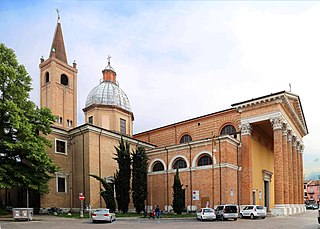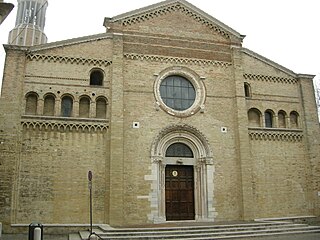
Amiternum was an ancient Sabine city, then Roman city and later bishopric and Latin catholic titular see in the central Abruzzo region of modern Italy, located 9 km (5.6 mi) from L'Aquila. Amiternum was the birthplace of the historian Sallust.
Atella was an ancient Oscan city of Campania, located 20km directly north of Naples.

Bettona is an ancient town and comune of Italy, in the province of Perugia in central Umbria at the northern edge of the Colli Martani range. It is 5 km (3 mi) E of Torgiano and 12 km (7 mi) SW of Assisi.
Aveia was an ancient town of the Vestini and Roman former bishopric, which remains a Latin Catholic titular see.

The Roman Catholic Diocese of Imola is a territory in Romagna, northern Italy. It is a suffragan of the Archdiocese of Bologna. The diocese had originally been a suffragan of the metropolitan of Milan, and was then subject to the Archbishop of Ravenna until 1582, when Pope Gregory XIII made Bologna an archbishopric and assigned it two suffragans, Imola and Cervia. In 1604, however, Pope Clement VIII returned them to the metropolitanate of Ravenna. Pope Pius VII transferred Imola back to the metropolitanate of Bologna.
The Roman Catholic Diocese of Ampurias was a Latin suffragan Catholic bishopric in the north of Sardinia from 1070 till its suppression and merger with the Diocese of Civita-Tempio into the present Roman Catholic Diocese of Tempio-Ampurias.

Brescello is a comune (municipality) in the Province of Reggio Emilia in the Italian region Emilia-Romagna, located about 80 kilometres (50 mi) northwest of Bologna and about 25 kilometres (16 mi) northwest of Reggio Emilia. As of 31 December 2016, it had a population of 5,621.

The Diocese of Rimini is a Latin Church ecclesiastical territory or diocese of the Catholic Church in Emilia Romagna, Italy. From earliest times, it was a suffragan to the Holy See, despite repeated attempts by the Diocese of Ravenna to claim it as a suffragan diocese. Since 1604, however, it has been a suffragan of the Archdiocese of Ravenna-Cervia.
Caudium was the main city of the ancient Caudini tribe in Samnium situated on the Appian Way between Beneventum and Capua, in what is now southern Italy. It was 21 Roman miles from Capua, and 11 from Beneventum. It, or nearby Arpaia, became the seat of an early bishopric, which is now a Latin Catholic titular see.
Saint Terentian(us) was Bishop of Todi who was killed during the reign of Hadrian (117–138).

The Roman Catholic Diocese of Concordia-Pordenone is situated in northeastern Italy, at the northern end of the Adriatic Sea, between Venice and Udine. Since 1818, Concordia Veneta, has been a suffragan of the Archdiocese of Venice. Bishop Andrea Casasola attended the Provincial Council of the Provincia Veneta in October 1859 as a suffragan of the Patriarch of Venice, Cardinal Giuseppe Luigi Trevisanato. The name of the diocese was changed to its present form in 1971.

The Diocese of Forlì-Bertinoro is a Roman Catholic ecclesiastical territory in Romagna, Italy. Until 1986 it was known as the Diocese of Forlì, in existence perhaps from the fourth century. In that year the Diocese of Bertinoro was united to it. The diocese is suffragan to the Archdiocese of Ravenna-Cervia.

The Diocese of Fano-Fossombrone-Cagli-Pergola is a Roman Catholic ecclesiastical territory in Italy, created in 1986, when the historical Diocese of Fano was united to the Diocese of Cagli e Pergola and the Diocese of Fossombrone. It is a suffragan of the Archdiocese of Pesaro.

Palatias and Laurentia are martyrs venerated by the Roman Catholic and Eastern Orthodox churches. According to tradition, Palatias or Palatia was an aristocratic Roman woman who was converted to Christianity by her wet nurse or slave Laurentia. They were executed for being Christians at Fermo, in present-day Italy, during the reign of Diocletian.

Saint Orontius of Lecce is venerated as a saint by the Roman Catholic Church, along with two other figures associated with his legend, Fortunatus and Justus. He is viewed as the first bishop of Lecce.

Quirinus is venerated as an early bishop of Sescia, now Sisak in Croatia. He is mentioned by Eusebius of Caesarea.

The Mausoleum of Helena is an ancient building in Rome, Italy, located on the Via Casilina, corresponding to the 3rd mile of the ancient Via Labicana. It was built by the Roman emperor Constantine I between 326 and 330, originally as a tomb for himself, but later assigned to his mother, Helena, who died in 330.
Civitella d'Arna is a frazione of the comune (municipality) of Perugia in central Italy, and the Ancient city and former bishopric Arna, which remains a Latin Catholic titular see.

Claternae, also called Claterna, was a Roman town on the Via Emilia situated between the coloniae of Bononia and Forum Cornelii. Like many other evenly spaced settlements on the Via Emilia, each at a day's march for the legionaries, it probably arose as a stopping place for travellers between the major towns.

Elpidius of Atella, or Elpidio in Italian, is a Christian saint. He was a bishop of the city of Atella, from 432 for about 20 years.














